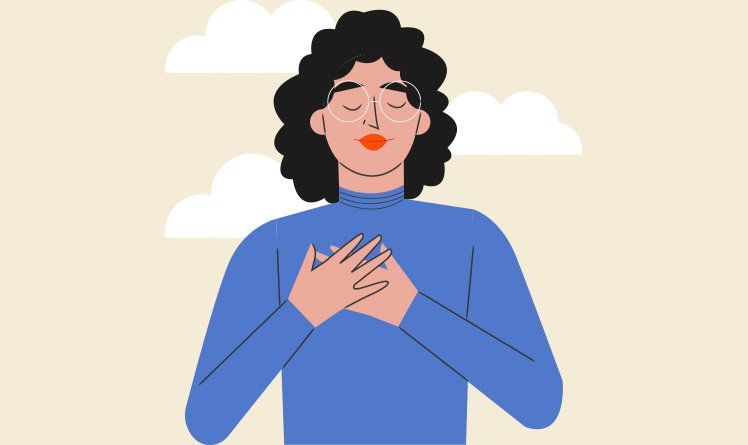Breathing Exercise: A Tool to Reduce Stress and Anxiety

|
Getting your Trinity Audio player ready...
|
Breathing is the first act of life, and also the last. But between these two extremes, most people spend decades without realizing the power that lies in this simple gesture. Thus, what should be natural has become automatic, and the automatic has disconnected us from ourselves. Above all, when we breathe unconsciously, we allow the body to live in survival mode; on the other hand, when we breathe with presence, we regain control of the mind.
In recent years, science has confirmed what ancient traditions already knew: breathing exercises are one of the most effective tools for reducing stress and anxiety, regulating emotions, and restoring mental balance. And best of all: it's always within your reach.
In this article, you'll understand how breathing influences your emotional state, why it can calm your brain in just a few minutes, and how to apply practical exercises that transform your body into an instrument of self-control and presence.
Why Breathing Is the First Step to Managing Stress and Anxiety
Have you ever noticed how, in moments of tension, your breathing becomes short, rapid, and shallow? It's the body's reflex, preparing to fight or flee. The problem is that, in modern life, this response isn't triggered by a predator, but by an email, a deadline, a criticism, or a constant worry.
THE breathing, above all, it's the only function of the autonomic nervous system that we can consciously control. And that's precisely why it's such a powerful key: when you change the rhythm of your breathing, you also change the message it sends to your brain.
The connection between breathing and the nervous system
The nervous system has two poles: the sympathetic, responsible for activation and alertness, and the parasympathetic, responsible for calm and recovery. Thus, when we breathe consciously, especially with longer exhalations, we activate the parasympathetic system, signaling to the body that it is safe.
It's as if the breath tells the brain, "It's okay, you can relax."“
The role of the vagus nerve and the amygdala
The vagus nerve, which extends from the brainstem to the abdomen, is the main conductor of this communication between body and mind. It regulates heart rate, digestion, and even mood. Therefore, the more we activate the vagus nerve through slow, deep breathing, the more balanced our emotional system becomes.
THE amygdala, the center of fear and anxiety, also responds directly to breathing. Neuroimaging studies show that slow breathing patterns reduce its activity, allowing the prefrontal cortex (the area of reason and decision-making) to regain control.
“A breathing exercise is a technique that guides the rhythm of inhalation and exhalation to balance the nervous system, reduce stress, and improve mental focus.”
Understanding what happens in the body during stress
Stress is a natural biological reaction. So, when faced with a threat, the brain releases adrenaline and cortisol, preparing the body for action. As the heart races, breathing shortens, and muscles tense. This response is useful in specific situations, but if sustained for too long, it turns into chronic anxiety.
In other words, when the mind is constantly on alert, the body also experiences exhaustion. In this sense, it's like keeping your foot on the accelerator all the time. And the engine overheats.
On the other hand, breathing exercises interrupt this cycle, slowing down the sympathetic nervous system and activating rest mode. It's like pressing the "pause" button on mental chaos.
“Deep breathing is calming because the long exhalation stimulates the vagus nerve, which is responsible for slowing the heart and modulating the release of cortisol, promoting a feeling of calm and well-being.”
Neuroscience of Breathing: How Air Changes the Brain
With each breath, millions of sensory receptors send signals to the brainstem. These signals then travel to the limbic system, responsible for emotions, and reach the prefrontal cortex, responsible for logical reasoning and impulse control.
The limbic system and emotional control
The limbic system, which includes structures like the hippocampus and amygdala, is profoundly affected by how we breathe. When we inhale shallowly and irregularly, we send a warning message. Similarly, when we lengthen our breath and exhale slowly, we signal safety.
This physiological change reduces heart rate, lowers blood pressure, and modulates the release of stress hormones. That's why, in just a few minutes of mindful breathing, your body begins to calm down, before you even "think" about calming down.
Prefrontal cortex activation and rational calm
Similarly, deep breathing also reactivates the prefrontal cortex, a region associated with focus, decision-making, and emotional self-regulation. Thus, when we breathe consciously, we regain access to our ability to think clearly.
In other words: breathing well is the biological antidote to reacting less and responding better.
“Breathing slowly and rhythmically activates the parasympathetic nervous system, reduces amygdala activity, and sends the brain a signal that the body is safe—breaking the cycle of anxiety.”
Neuroplasticity and conscious emotional regulation
Regular practice of breathing exercises creates neural connections: a phenomenon called neuroplasticity. In other words, this means that, over time, your brain learns to enter calm states more easily. It's like training an invisible muscle: the more you practice, the faster it responds.
“Conscious breathing changes the brain, as regular practice stimulates neuroplasticity, strengthening the prefrontal cortex and reducing automatic stress reactions.”
Top breathing exercises to reduce stress and anxiety
Now let's move on to the practical aspects. Each technique below is scientifically based and can be applied at different times of the day, depending on your needs: focus, relaxation, or balance.
Diaphragmatic (or abdominal) breathing
This is the foundation of all breathing practices. Sit comfortably, place one hand on your chest and the other on your abdomen. Inhale through your nose, feeling the air fill your belly before your chest. Exhale slowly through your mouth.
This breathing pattern activates the diaphragm, stimulates the vagus nerve, and reduces heart rate. Within minutes, the body begins to shift out of its state of alert.
4-7-8 Technique
Created by Dr. Andrew Weil, it's simple and extremely effective for reducing anxiety and facilitating sleep. Inhale through your nose for a count of 4, hold it for a count of 7, and exhale slowly through your mouth for a count of 8.
This pattern prolongs exhalation, which increases oxygenation to the brain and calms the nervous system.
Alternate Breathing (Nadi Shodhana)
Of yogic origin, this technique balances the hemispheres of the brain. Close your right nostril with your thumb, inhale through the left, close it, and exhale through the right. Then reverse the process.
It is ideal for moments of emotional imbalance or indecision, as it restores harmony between reason and emotion.
The Physiological Sigh (Stanford Medicine)
Validated by recent neuroscience studies, this technique is natural and occurs spontaneously when the body tries to relieve stress. It's quite simple. So, let's do it: inhale twice in a row (one long breath and one short breath) and exhale slowly through your mouth.
Repeating this pattern for 1 to 2 minutes reduces the level of carbon dioxide in the blood and provides almost immediate relief from physical and mental tension.
“The 4-7-8 pattern is one of the most effective breathing exercises: inhale for 4 seconds, hold for 7, and exhale for 8. This rhythm regulates the heart rate and induces almost immediate relaxation.”
Breathing as a tool for mental reprogramming
Breathing well is more than a physiological technique. In short, it's an act of consciousness. Above all, breathing is the gateway between the unconscious and the conscious, and therefore plays an essential role in mental reprogramming practices.
Mindfulness and mindfulness
Node mindfulness, breathing is used as an anchor to the present. Thus, observing the air coming in and out without trying to control it trains the brain to stay here and now. This reduces rumination mental — that inner voice that lives in the past or the future — and creates space for clarity.
NLP and breathing as an emotional anchor
In Neurolinguistic Programming, we use breathing as a trigger for emotional states. In other words, you can associate deep breathing with feelings of confidence or tranquility. With practice, simply taking a deep breath will access the desired state.
Positive Psychology and mental states of well-being
Breathing also influences positive emotions. Studies show that people who breathe rhythmically and consciously experience more gratitude, optimism, and calm—pillars of positive psychology. Thus, simply changing your breathing rhythm alters how your brain interprets the world.
Guided Practice: 3 Minutes to Reconnect with the Now
Stop for a moment. Wherever you are, sit comfortably. Now, close your eyes. Inhale deeply through your nose, counting to four. Hold it for a brief moment, then exhale slowly through your mouth, counting to six.
As the air enters, imagine that you are breathing in calm.
As he leaves, imagine that he is releasing all the accumulated tension.
Then repeat for three minutes. Notice how your body changes: your shoulders drop, your heart slows, and your mind becomes quieter.
This simple exercise is enough to interrupt the flow of anxiety and reprogram the brain for the present.
Avoiding Pitfalls About Breathing Exercises
Some people start practicing and think, "It seems like deep breathing makes me even more anxious." This is because when there's too much focus on breathing, the body can interpret the attention as a sign of control, and control is the opposite of surrender.
The key is to observe, not force. In this sense, breathing better is not about breathing more — it's about breathing with presence (remember the mindfulness).
Another common mistake is trying to “eliminate” the anxiety all at once. Breathing doesn't erase emotions. On the contrary, it creates space to feel them without being overwhelmed by them.
Remember: the goal is not to control your breathing, but to let it teach you the way back to calm.
How to make breathing a daily habit
THE neuroscience shows that repetition creates automatic pathways in the brain. However, this applies to both bad and good habits. Therefore, if you set aside small moments throughout the day to breathe consciously, your body will learn to balance itself more quickly.
You can start with micro habits:
- Before opening your phone in the morning, take three slow, deep breaths.
- Before each meal, breathe for one minute.
- When lying down, practice the 4-7-8 pattern.
These pauses are like little resets for your nervous system. Over time, mindful breathing will become a natural part of your day—not just an emergency resource for moments of crisis.
Conclusion: Breathe, slow down, and take back control
Breathing is the meeting point between body, mind, and emotions. When you learn to use it consciously, you have at your disposal a powerful tool—simple, free, and always available—to reduce stress, calm anxiety, and reconnect with your essence.
Breathing well means living with greater presence. It's reminding yourself, several times a day, that now is enough. So, take a deep breath… and allow yourself, for a few seconds, to simply be.
“Ideally, you should practice breathing exercises several times a day for one to three minutes, especially before stressful situations or at night, to train your brain to relax naturally.”
FAQ – Questions and Answers about breathing exercises
1. What is the best breathing exercise for anxiety?
The most effective is one that slows your breathing and lengthens your exhalation, such as the 4-7-8 or the physiological sigh. Both activate the parasympathetic system and quickly calm the brain.
2. How many minutes a day should I practice?
Five minutes is enough to notice the benefits. Ideally, practice throughout the day, taking short breaks of one or two minutes.
3. Do breathing exercises replace anti-anxiety medications?
They can complement treatment and reduce the need for medication in some cases, but should not replace it without medical advice.
4. Why does taking deep breaths sometimes make anxiety worse?
Because trying to "over-control" your breathing can lead to hyperventilation. Ideally, you should inhale and exhale lightly, fluidly, and naturally.
5. Does conscious breathing help with sleep and concentration?
Yes. Rhythmic breathing reduces amygdala activity and improves nervous system regulation, facilitating relaxation and focus.
Image: Freepik

Marcel Castilho is an expert in neuromarketing, neuroscience, mindfulness and positive psychology. In addition to being an advertiser, he also has a Master's degree in NLP – Neurolinguistic Programming. As the owner and founder of the communications agency VeroCom and also of the digital agency Vero Contents, he has been studying human behavior for over 30 years.

